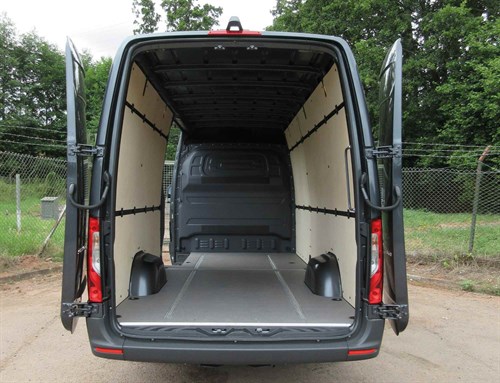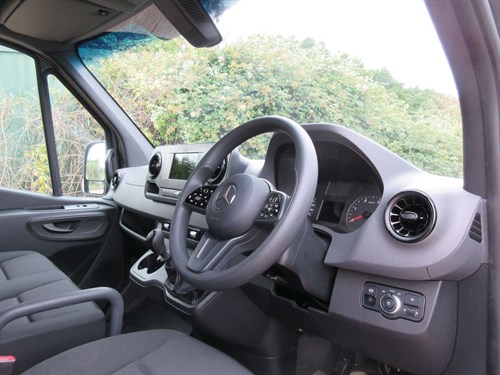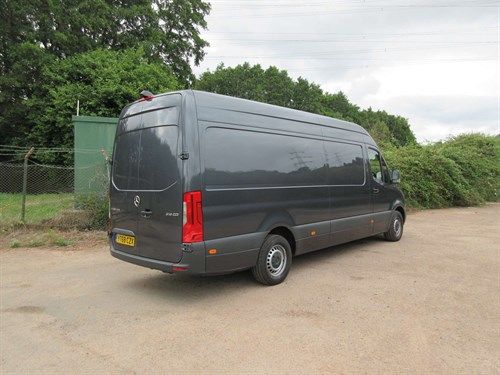Vans on home delivery work take a relentless hammering.
Constantly stopping and starting, bounced up over kerbs, and with their cargo area doors wrenched open and slammed shut umpteen times a day, they have to be remarkably robust to withstand the battering they receive.
That is why so many home delivery fleets opt for Mercedes-Benz’s Sprinter. Experience has shown them that it will withstand all the punishment it will receive without falling to bits.
The Sprinter underwent a major redesign not long ago, and one of the key developments is the addition of front-wheel drive (FWD) to the line-up. Previous models were rear- or four-wheel drive only, and both layouts remain available.
FWD gives you a loading height that is 80mm below that of rear-wheel drive (RWD) variants – good news if you are stepping in and out of the cargo area all day. Payload capacity is 50kg higher – a modest increment, but still worth having – and you get 0.5m3 more load space.
No changes have been made to the engines other than the introduction of a keyless push-button starting system. No disrespect to Mercedes, but we remain dubious about such starting arrangements on security grounds.
The Sprinter is still listed with 2.1-litre diesels at 114hp, 143hp and 163hp as well as with the always impressive 190hp V6 3.0-litre diesel that, alas, is not offered in FWD derivatives.
Nor is the 163hp engine.
Changes have been made to the transmission, however, with the arrival of an optional (and highly desirable) nine-speed 9G-Tronic automatic gearbox. You can choose it if you opt for FWD – go RWD and you are restricted to a seven-speed 7G-Tronic auto as an option. A new six-speed manual gearbox is standard across the range. In the pipeline is an electric Sprinter, which should appear on this side of the Channel during Q1 of next year.
FWD Sprinters gross at from 3.0-4.1t while their RWD counterparts gross at from 3.0-5.5t.
Top payload capacity is 3,150kg if you select the 5.5-tonner while maximum load cube ranges from 7.8-17.0m3.
Vans are marketed with three load compartment heights and four body lengths and the Sprinter is additionally sold as a crew van, a chassis cab and as a chassis double-cab.
Mercedes has also come up with tipper, dropside and Luton conversions.
We went for a manual 316DCI powered by the 163hp diesel married to the six-speed gearbox with the third-longest length (L3) and the second-highest roof (H2) listed. It had a lot of options fitted, and it wasn’t cheap.

Load bay
Access to the 14.0m3 cargo area is by means of a sliding nearside door with a step just inside plus twin rear doors that can be swung through 270º against the van’s sides.
The big side and rear door apertures both boast grab handles to aid access.
Securing cargo had we needed to would have presented no difficulties thanks to the presence of 10 floor-mounted tie-down points plus two more at the base of the full-height steel bulkhead.
Load-locking track – an extra-cost option – was set into the vehicle’s fitted cargo bed cover and the sides and doors were partially protected by timber panels for an additional charge, a courtesy not extended to the vulnerable wheel boxes.
There are no less than four load area lights plus a shelf above the cab accessible solely from the cargo bay– an ideal place to stow load lashing straps.
A key drawback? At 1,078kg payload capacity is modest.

Interior and equipment
Climb into a 3.5-tonner’s cab – a three-seater in this case – and you automatically reach for a grab handle to pull yourself aboard. Ideally, it should be on the A-pillar, but Mercedes has decided to position it on the door instead with a second one above the door aperture.
The door-mounted grab handles are extra-cost options, as is the handle mounted between the driver and passenger seat for the inboard passenger to cling to. While its provision may be laudable, its positioning makes things rather awkward for any driver who wants to slide across the cab and step out safely onto the pavement. A ceiling-mounted handle might make more sense.
It seems a little odd to see items such as these (not to mention the bulkhead-mounted coat hook) listed as options rather than included in the price.
Once you settle down behind the wheel you are faced with a rather dull-looking dashboard whose main feature is a seven-inch touchscreen, which governs the Mercedes-Benz User Experience (MBUX) multimedia system. Both the seat and steering wheel are height-adjustable and the latter plays host to the remote controls for the standard DAB radio.
Opening the driver’s door switches the radio off so you don’t disturb slumbering householders when making deliveries late at night.
Bluetooth connectivity is available and the touchscreen can play host to Apple CarPlay and Android Auto.
The three-seater cab offers more generous shoulder room for everybody than one might expect. Although the occupant of the middle seat suffers restricted legroom, it should not pose too much of a problem on short trips.
You get plenty of storage space for your money although we would rather see a lidded and lockable glove box instead of an open shelf. There are two bins in each of the cab doors, shelves on top of the dashboard, and shelves above the windscreen on both the driver and passenger side.
Mercedes clearly expects the occupants of the cab to spend a lot of time drinking tea or coffee. No less than four cupholders are mounted on top of the dashboard (one of which plays host to a removable ashtray that will hopefully be used solely as a mini waste bin instead) and there are two more on the front of the fascia next to the gear lever.
Satnav was installed as was semi-auto aircon. They are both options at extra cost, as are the reversing camera – its images are displayed on the aforementioned touchscreen and it is not complemented by reversing sensors – and the electrically adjustable and heated exterior mirrors.
Electric windows are included in the overall deal, as are cruise control, a USB socket and a driver’s airbag.
Satnav gets you the Hey Mercedes voice command system. Ask it where the closest service stations are, for example, and it will give you a list, tell you which brands of fuel they sell and provide directions to whichever one you select. That can be invaluable if you are in an unfamiliar area of the country.
Also provided is What3words – a geocoded mapping system that will direct you to within 3m of any location in the world. The Sprinter’s cab can also become a wi-fi hotspot with a permanent internet connection subject to a data contract with Vodafone.
As well as ABS and adaptive electronic stability programme, electronic onboard safety systems include hill-start assist, active brake assist, and crosswind assist.
Active brake assist can apply the brakes automatically if it senses a hazard – a pedestrian stepping out in front, for instance – and the driver fails to take action. Crosswind assist reacts to sudden gusts of wind on, for example, exposed sections of motorway, and responds with targeted braking to stabilise your van. Attention assist, meanwhile, displays a coffee cup symbol on the instrument panel when it reckons you are getting drowsy and need a break.
If it all goes wrong and your Sprinter breaks down then help can be summoned at the touch of a button. Breakdown Management establishes a data and voice connection to the vehicle and enables – hopefully prompt – MobiloVan and Service24h assistance.
It is one of a whole range of services that are available with a connected Sprinter. Some of them are free, some are free for the first three years, and some -–available from the Mercedes Pro eStore – may attract a charge.
Pro packages include Efficient Driving Style Analysis. It records data on an individual’s behaviour at the wheel, which can then be used to achieve improvements, thereby reducing fuel consumption and increasing safety.
This praiseworthy stress on connectivity as part of the manufacturer’s adVANce programme is one of the most important changes to the Sprinter, and potentially far more significant than any of the hard metal alterations.

Engine and gearbox
Maximum power kicks in at 3,800rpm while top torque of 360Nm bites across a 1,400-2,400rpm plateau.
AdBlue held in a 22-litre reservoir ensures that the four-cylinder 16-valve turbocharged and intercooled common-rail engine meets Euro6 emission requirements.
Driving
Speed-sensitive electric power steering is standard and delivers a 15.2m turning circle between kerbs rising to 16.1m between walls.
Independent suspension is installed at the front while parabolic springs help to support the rear. Our Sprinter’s 16in steel wheels were shod with Continental VanContact 200 235/65/R16C tyres.
The optional electric handbrake release – you flick a switch on the dash – works fine once you get used to it.
Lightly laden, and with 163hp on tap, our Sprinter accelerated strongly away from rest and continues to deliver power seamlessly all the way up the rev band. We were impressed by the engine’s flexibility, which meant we rarely had to change gear – just as well because the gear-change lacks crispness.
While wind and road noise could stand to be better controlled, any noise from the engine is muted, and rarely makes its presence felt in the cab. Smooth and dependable, the handling allows you to sweep majestically through bends without having to worry that something will go wrong.
Accompanied by a good deal of bouncing around, the Sprinter’s ride isn’t its strong suit if you only have a few kilos in the back.
However, the vehicle seems to be frugal. We were getting around 36mpg – not far short of the official combined figure. Stop/start was fitted, which helped keep fuel usage down.
Active brake assist cut in twice during our test: once when a car swung in front of us, but once when it appeared to confuse street furniture positioned close to the kerb with a vehicle.
It is a phenomenon we have noticed before with this type of system and although it is annoying, it’s one that a driver can probably learn to live with – just so long as it doesn’t happen every five minutes.

Operating
Service intervals are set at up to two years/37,000 miles for RWD Sprinters. A three-year/unlimited mileage warranty is provided and roadside assistance is available free of charge for up to 30 years, believe it or not, subject to certain obligations and exclusions. Deep side rubbing strips should help protect the Sprinter against minor damage.
Mercedes-Benz Sprinter 316 CDI L3 H2 RWD
Price (ex VAT) £35,650
Price range (ex VAT) £25,550-£52,050
Gross payload 1,078kg
Load volume 14.0m3
Load length 4,307mm
Load width (min/max) 1,350/1,787mm
Load bay height 1,940mm
Loading height 785mm
Rear door aperture 1,565×1,840mm
Side door aperture 1,300×1,820mm
Gross vehicle weight 3,500kg
Braked trailer towing weight 2,000kg
Residual value 23.2%*
Cost per mile 65.2p
Engine size/power 2,143cc, 163hp @ 3,800rpm
Torque 360Nm @ 1,400-2,400rpm
Gearbox 6-spd
Fuel economy 37.2mpg (combined)
Fuel tank 71 litres
CO2 199g/km
Warranty 3yrs/unltd miles
Service intervals 2yrs/37,000mls
Insurance group 43E
Price as tested £40,780
*after 4yrs/80,000mls; source: KwikCarcost
Options fitted
Tempmatic semi-auto aircon £1,000
Parking Package with reversing camera £905
Satellite navigation £690
Tenorite grey metallic paint £685
Blindspot assist inc. heat/elect. adjust. mirrors £640
Load space trim £295
Electric parking brake £270
Load securing rail system £230
Shelf above cab £150
Radiator grille frame in body colour £95
Grab handles for driver and passenger doors £65
Grab-handle for middle seat £45
Smoker’s Package £40
In-cab coat hook £20
Rivals
Ford Transit
Price (ex VAT) £26,235-£38,600
Load volume 9.5-15.1m3
Gross payload 872-2,169kg
Engines 105hp, 130hp, 170hp, 185hp 2.0 diesel, 130hp 2.0 hybrid diesel
Verdict: Going on sale at the time of writing, the latest version of the all-conquering Transit comes with a mild hybrid diesel powertrain, a new 185hp version of its 2.0-litre diesel, a revised front end and a new interior. It’s bound to be yet another UK success story for Ford, and the one all its rivals will have to beat. Look out for the 10-speed automatic transmission scheduled for rear-wheel drive models in early 2020.
Peugeot Boxer
Price (ex VAT) £23,980-£33,875
Load volume 8.0-17.0m3
Gross payload 1,125-1,570kg
Engines 120hp, 140hp 2.2 diesel
Verdict: An often underrated but surprisingly competent package, the Boxer has recently been revised, with a new engine plus new trim levels. Its near-identical Citroen Relay stablemate has received the same changes, and electric versions of both were unveiled at the CV Show earlier this year. Sharing the same basic design, Fiat’s Ducato has been upgraded too, and all three are worth further investigation.
Volkswagen Crafter
Price (ex VAT) £25,385-£42,485
Load volume 9.3-17.5m3
Gross payload 735-2,573kg
Engines 102hp, 122hp, 140hp, 177hp 2.0 diesel
Verdict: A solidly constructed and well thought-out alternative, it too is marketed with front-, rear- and four-wheel drive, and is available with a comprehensive package of safety features. Front assist with city emergency braking is a potential life-saver on busy city streets. An electric e-Crafter should be here next year. The Crafter is also marketed by MAN as the TGE.
The Final Verdict
|
Design |
9/10 |
A stress on wi-fi hotspot and connected services is important.
|
|
Cabin |
9/10 |
Comfortable and roomy, with lots of storage, |
|
Ride |
7/10 |
Unladen ride is choppy but improved once some weight went in. |
|
Refinement |
7/10 |
No rattles thanks to high build standards. Engine noise is muted. |
|
Load area |
8/10 |
Roomy and easy to access, with plenty of load tie-down points. |
|
Handling/performance |
8/10 |
Former’s dependable; latter offers smooth acceleration. |
|
Engine/transmission |
7/10 |
Flexible, frugal engine is a bit let down by not so crisp gear change. |
|
Standard equipment |
7/10 |
The basics are there. |
|
Operating costs |
8/10 |
Long service interval, decent mpg and hopefully strong RVs. |
|
What Van? subjective rating |
8/10 |
Connectivity and safety are the two key characteristics. |
Overall Rating = 78/100





